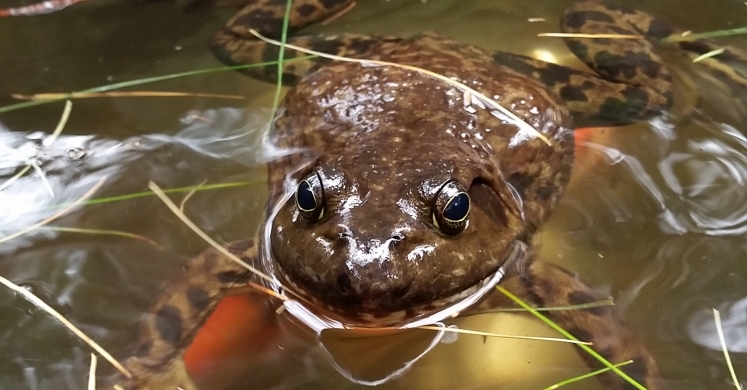Blog

#bioPGH Blog: American Bullfrogs
 A resource of Biophilia: Pittsburgh, #bioPGH is a weekly blog and social media series that aims to encourage both children and adults to reconnect with nature and enjoy what each of our distinctive seasons has to offer. From the best times to plant seasonal flora and enjoy their peak blooms, to astronomical events and creatures to keep an eye and ear out for, Phipps will keep you in the know with what’s going on in our environment!
A resource of Biophilia: Pittsburgh, #bioPGH is a weekly blog and social media series that aims to encourage both children and adults to reconnect with nature and enjoy what each of our distinctive seasons has to offer. From the best times to plant seasonal flora and enjoy their peak blooms, to astronomical events and creatures to keep an eye and ear out for, Phipps will keep you in the know with what’s going on in our environment!
If you live by, or have visited, any relatively calm body of freshwater, such as a pond or lake, you may have begun noticing more and more acoustic commotion as choruses of deep bellowing calls begin reverberating across the water just before sunset. These low drones are the sultry mating calls of the male American bullfrog (Lithobates catesbeiana, previously Rana catesbeiana):
These extremely territorial amphibians will aggressively guard their piece of “land” from other males, including eating their competition should they get too close. This kind of cannibalistic behavior is not uncommon for bullfrogs, as bullfrogs are opportunistic ambush predators that will eat whatever they can fit in their mouths. This includes everything from insects,small birds,small mammals, fish, reptiles, crustaceans and other amphibians. The American bullfrog is the largest and most widely distributed species of frog in North America,and both adult frogs and tadpoles play a critical role in small animal and insect population control as well as in energy transfer throughout the environment. Did you know that bullfrog tadpole development is actually quite slow? It can take between one to three years for the tadpoles to transition into their adult stage! And, once they transition into adult phase it can take up to an addition two years for the frog to reach sexual maturity.
Connecting to the Outdoors Tip: What better way to learn about these big old brown-green amphibians than to raise your very own or get out there and catch and release some? One exciting upcoming event promises to bring together volunteer scientists, families, students, teachers and community members to conduct a biological survey of all of the living species in a given area, including American bullfrogs! Help us see how many bullfrogs we can find at Phipps’ first-ever BioBlitz festival on Sun., June 5! Not only are these surveys fun to participate in, they also help scientist document and assess regional biodiversity and allow us to learn more about the health of our environment and how we can support its conservation! By participating, you'll witness firsthand the amazing biodiversity right here at Phipps Conservatory and Pittsburgh’s Schenley Park, participate in real-time science, create unique art, browse local vendors' products and goods, engage with interactive exhibits, enjoy live music and much more! This event is free to the public so mark your calendar and come help us and local scientists learn about all the critters that call Pittsburgh’s parks home! Get little ones excited for outdoor adventures searching for bullfrogs and other native amphibians with one or two of these eighteen different frog crafts!
Continue the Conversation: Share your nature discoveries with our community by posting to Twitter and Instagram with hashtag #bioPGH, and R.S.V.P. to attend our next Biophilia: Pittsburgh meeting.
Additional Resources:
American Bullfrog | National Aquarium in Baltimore
American Bullfrog | National Geographic
American Bullfrog | University of Michigan BioKIDS
American Bullfrog Call | YouTube
A Tadpole to Frog Observation Tank | The Craft Train
Raising Tadpoles | Racheous
BioBlitz | Phipps Conservatory and Botanical Gardens
Cute Frog Crafts for Kids to Create | Crafty Morning

